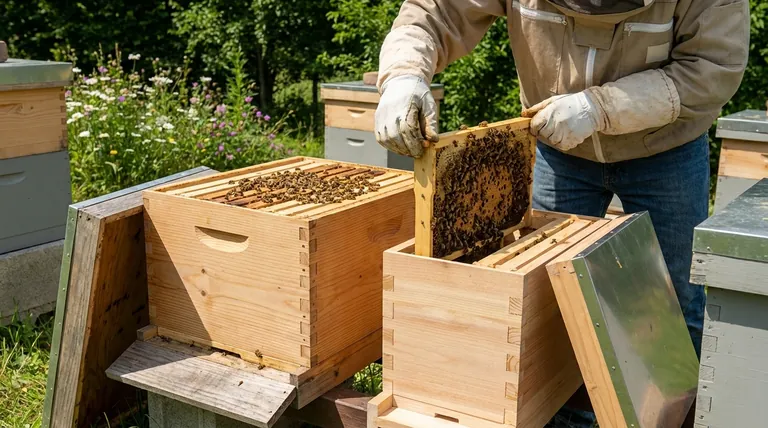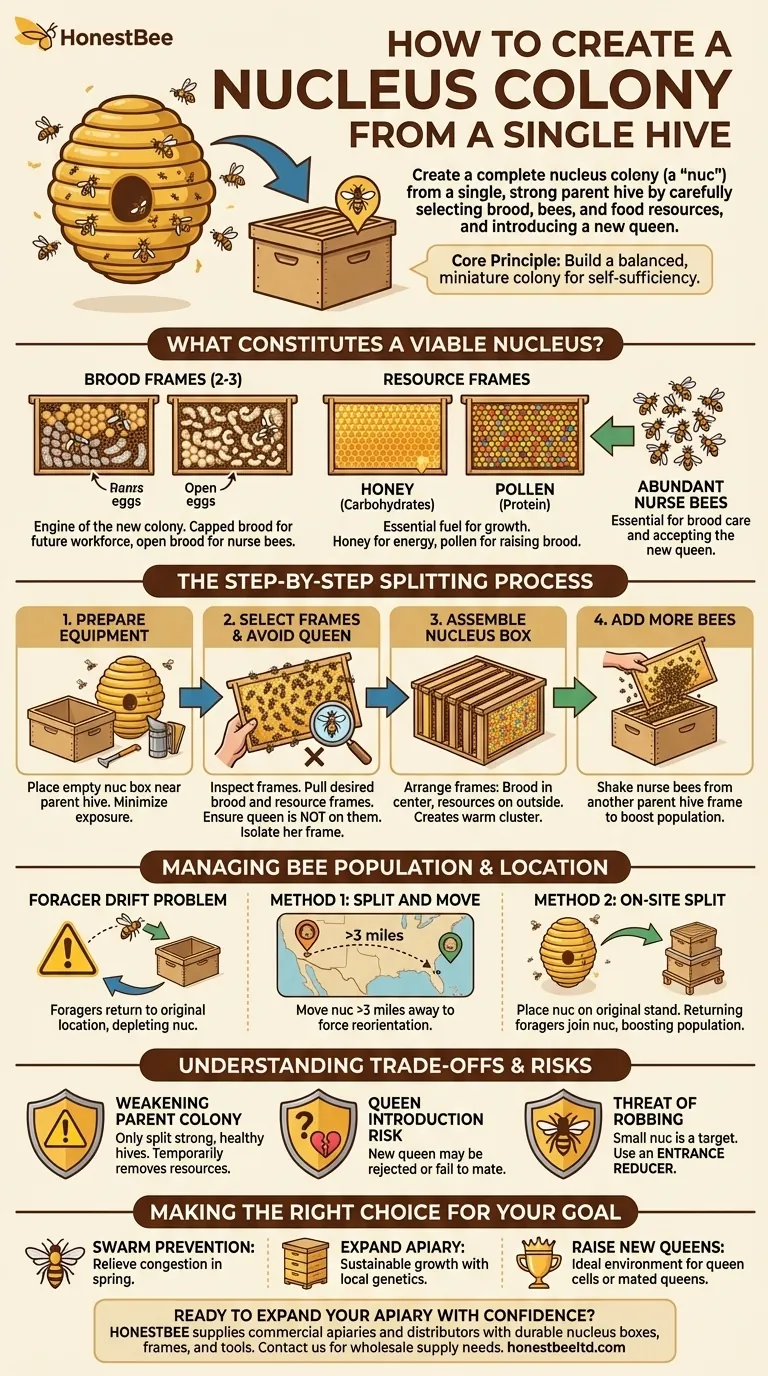Yes, you can create a complete nucleus colony (a "nuc") from a single, strong parent hive. The process involves carefully selecting frames of brood, bees, and food resources from the parent colony, moving them into a smaller nucleus box, and introducing a new queen. This method is fundamental to expanding your apiary, managing swarms, and raising new queens.
Creating a nucleus isn't simply about dividing a hive; it's about building a balanced, miniature colony with everything it needs to become self-sufficient. Success hinges on providing the new nuc with the right combination of young bees, developing brood, and sufficient food to sustain it until a new queen is established and laying.

What Constitutes a Viable Nucleus?
Before you begin, you must understand the components of a successful nuc. Your goal is to replicate a full-size colony on a smaller scale, typically in a five-frame box.
The Core of the Colony: Brood Frames
Your nuc should have two to three frames of brood. These frames are the engine of the new colony. They should contain brood in all stages: eggs, larvae, and capped pupae.
Capped brood provides a continuous supply of new bees that will emerge over the next one to two weeks, rapidly increasing the nuc's population. Open brood (eggs and larvae) ensures the presence of young nurse bees, who are critical for caring for the new queen.
The Fuel for Growth: Resource Frames
The remaining two frames should be dedicated to resources. One frame should be mostly honey to provide carbohydrates for energy, and the other should contain pollen or "bee bread" to provide protein for raising new brood.
The Right Population: Abundant Nurse Bees
When you transfer the brood frames, you must ensure the bees covering them come along. These are primarily young nurse bees who are essential for caring for the brood and, most importantly, for accepting and tending to the new queen you will introduce.
The Step-by-Step Splitting Process
With a clear understanding of the goal, the process itself is straightforward.
Step 1: Prepare Your Equipment
Have your empty nucleus box ready and placed near the parent hive. This minimizes the time the frames are exposed.
Step 2: Select the Right Frames
Open the parent hive and carefully inspect the frames. Pull your desired frames of brood and resources, ensuring they are covered in bees. Gently shake off some of the older bees, as the younger nurse bees tend to cling to the brood frames.
Never take the frame the original queen is on. Find her and isolate that frame to ensure she stays with the parent colony.
Step 3: Assemble the Nucleus Box
Place the frames into the nucleus box. A common and effective arrangement is to put the brood frames in the center, flanked by the pollen and honey frames on the outside. This creates a warm, well-provisioned central cluster.
Step 4: Add More Bees
To ensure the nuc is populous enough, find another frame of brood from the parent hive (after confirming the queen isn't on it) and shake the bees from it directly into the new nuc box. These young bees will stay, boosting the initial population.
Managing Bee Population and Location
Where you place the nuc after creating it is one of the most critical decisions you will make.
The Forager Drift Problem
Bees are creatures of habit. If you place the new nuc in the same apiary as the parent hive, all the older forager bees will fly out and navigate back to their original hive location. This "forager drift" will severely deplete the nuc's population, leaving it too weak to survive.
Method 1: The "Split and Move" Technique
The most common solution is to move the new nuc to a different apiary, at least three miles away. This distance forces all the bees to reorient themselves to the new location, preventing them from returning to the parent hive. After a few weeks, once the new queen is laying, you can move it back if desired.
Method 2: The "On-Site Split" Technique
If you cannot move the nuc, you can use the bees' navigational instincts to your advantage. Move the original parent hive to a new spot in the apiary and place the new nuc on the original hive stand.
Returning foragers, unable to find their hive, will discover the nuc and join it. This dramatically boosts the nuc's population while slightly weakening the parent colony, which also serves as a form of swarm control.
Understanding the Trade-offs and Risks
Creating a nuc is powerful, but it's not without consequences that you must manage.
Weakening the Parent Colony
Making a split will temporarily weaken the parent colony. You are removing its resources and future workforce. For this reason, you should only ever split a strong, healthy, and populous hive. Splitting a weak hive will likely cause both colonies to fail.
The Risk of Queen Introduction
The new nuc must be given a new queen. This is typically done by adding a queen cell or a caged, mated queen. There is always a risk the bees will not accept her, the queen cell won't emerge, or a new virgin queen won't mate successfully.
The Threat of Robbing
A small nuc is a prime target for robbing by stronger hives. Always use an entrance reducer to give the small population a defensible entrance.
Making the Right Choice for Your Goal
With these principles in mind, you can apply the technique to meet your specific beekeeping objectives.
- If your primary focus is swarm prevention: Splitting your strongest colony in mid-spring is an excellent way to relieve congestion and preempt their natural swarm impulse.
- If your primary focus is expanding your apiary: Making nucs is the most sustainable method for increasing your colony count using your own proven, locally adapted bee genetics.
- If your primary focus is raising new queens: A nuc provides the perfect, small-scale environment to introduce a valuable queen cell or a newly mated queen and monitor her acceptance and performance.
By thoughtfully balancing the needs of the new nuc, you can reliably turn one strong colony into two and guide the growth of your apiary.
Summary Table:
| Component | Details | Key Considerations |
|---|---|---|
| Brood Frames | 2-3 frames with eggs, larvae, capped brood | Provides the colony's future workforce and nurse bees. |
| Resource Frames | 1 frame honey, 1 frame pollen | Essential fuel for the new colony's growth and survival. |
| Bee Population | Young nurse bees from brood frames | Critical for accepting a new queen and caring for brood. |
| Location Strategy | Move nuc >3 miles away or use on-site split technique | Prevents forager drift and ensures population stability. |
Ready to expand your apiary with confidence? Creating strong, healthy nucleus colonies requires reliable, high-quality equipment. HONESTBEE supplies commercial apiaries and beekeeping equipment distributors with the durable nucleus boxes, frames, and essential tools needed for successful splitting operations. Let our wholesale-focused expertise support your growth. Contact our team today to discuss your beekeeping supply needs!
Visual Guide

Related Products
- 5 Frame Wooden Nuc Box for Beekeeping
- HONESTBEE Professional Long Handled Hive Tool with Precision Cutting Blade
- HONESTBEE Advanced Ergonomic Stainless Steel Hive Tool for Beekeeping
- Professional Dual-End Stainless Steel Hive Tool for Beekeeping
- Multi-Function Plier-Style Frame Grip Hive Tool
People Also Ask
- What is the advantage of overwintering a nucleus? A Strategic Asset for Beekeeping Success
- What are the benefits of using nucs for beginning beekeepers? Ensure a Successful First Hive with a Head Start
- How should the nuc be installed in the apiary? Ensure Colony Success from Day One
- What is the most common type of standard nuc? The 5-Frame Nuc Explained
- What are the benefits of starting a new bee colony in a nuc box? Boost Colony Success with Efficient Beekeeping



















